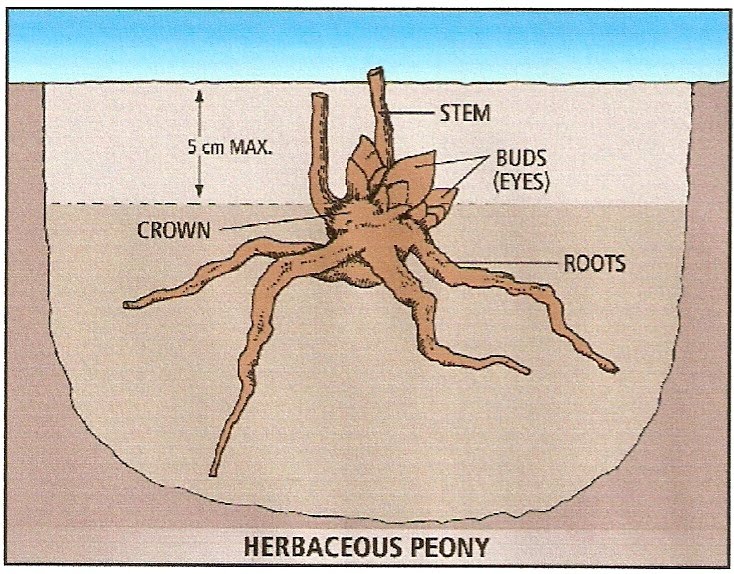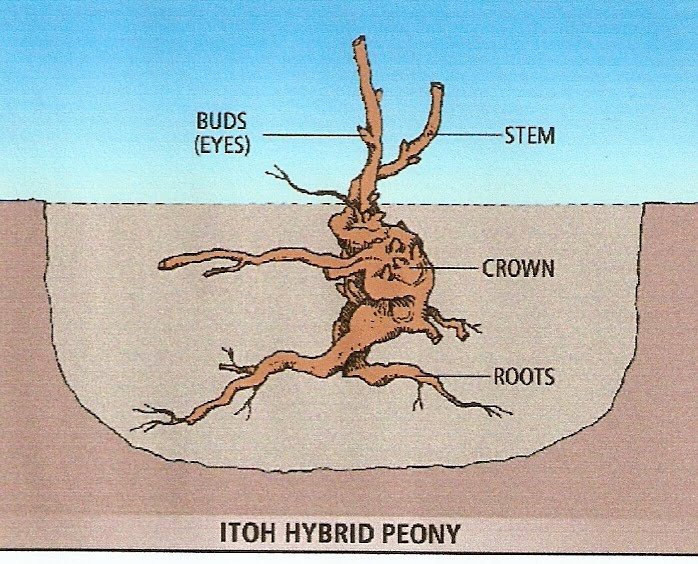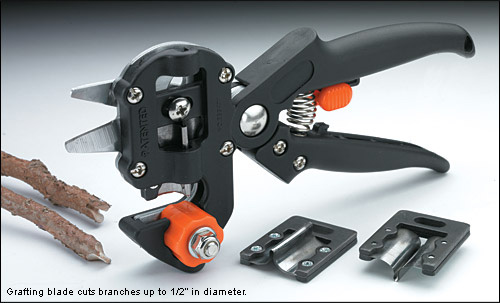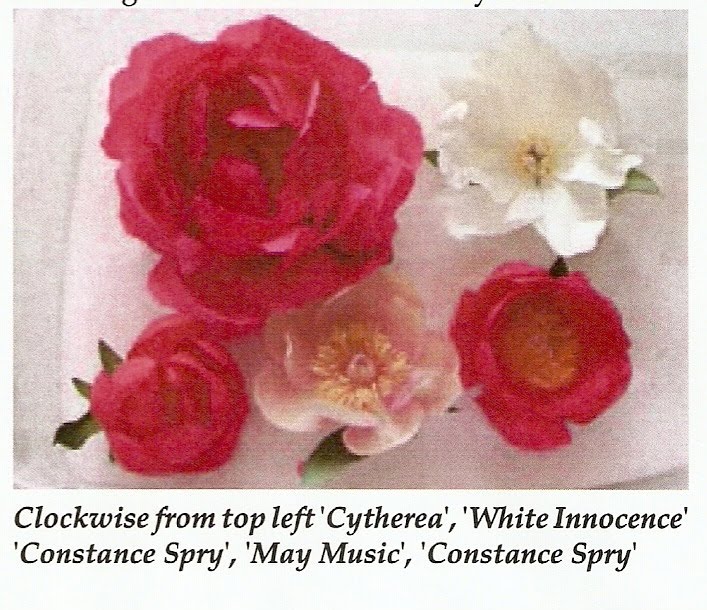Planting / Care / Drying / Cutting / Storing
- Planting of Herbaceous and Intersectional Hybrids
- Seasonal Care for Herbaceous and Intersectional Hybrids
- Tree Peonies
- Drying Peonies
- Hybridizing your Own Peonies
- Cutting and Storing Peony Flowers for Later Use
There are over 5,000 varieties of the common garden or herbaceous peony. Fall is the opportune time to plant your freshly dug roots. If you purchase a potted root these can be planted anytime of the year. Plant the crown at no deeper than 2" below soil. If too low or too high it will hinder flowering. Plant in full sun with well drained soil. Never plant your peony in the same location where another peony has been planted before. Plant with well rotted manure in the planting hole and never use fresh manure. Make sure that the eyes and crown do not come into contact with the manure. Make sure to mulch your peony the first winter after planting. Remove mulch in spring when first roots emerge from soil. All peonies require a cold period (vernalization)
Spent flowers can be removed or left on, as you like. Some peonies, especially singles and semi-doubles, produce decorative seed heads after flowering. If you are collecting peony seeds, they are ripe just when pods begin to open in the fall. Peony cultivars do not come true from seed but seeds can be planted and many will germinate and grow, potentially giving new varieties.
Fertlizing may not be necessary if planted in heavy clay, however in sandy soil periodic top dressing with well aged compost in the fall helps maintain soil fertility. Apply compost around the peony but not directly on the crown. You can also use non-organic fertilizers as long as amounts of nitrogen are lower than the phosphorous and potassium. A ratio of 1:2:1(Nitrogen: Phosphorous: Potassium) is often recommended. There are no fertilizer recommendations that are applicable to all situations, but if you feel you have to fertilize, apply a half cup of 10-15-10 in early spring and another half cup just after flowering.
Once established peonies are reasonably drought resistant. If the first spring after planting is very dry the plants will benefit from receiving some water. Drip irrigation is always preferred to overhead watering as it reduces the chances of fungal diseases.
Herbaceous and species:
When planting your herbaceous roots make sure that the bud (little pink nub) is 1" to 2" below soil level. A 3 to 5 eye root will generally flower within 2 years of planting.

Plants will grow between 2 and 4feet tall, in a sunny location (at least 6 hours)in well drained, organic rich soil. Although peonies will tolerate a wide range of soil types. Top dress your peonies each fall with compost to improve soil structure and remember not to place compost directly on crown of plant. Never use fresh manure.
Intersectionals:
Planting Itersectional Hybrids (cross between a herbaceous and a tree peony) are a little different than herbaceous. Like the herbaceous they like full sun (6 hours or more) and well drained compost rich soil. They can grow up to 4 feet across and live for years with minimal care. Plant your root so the first eye above the crown is at soil level. Eyes may be on the crown or the stem. All visible eyes on crown should be 5 to 10cm under the soil surface and roots always pointing downward. Remember to mulch your Itoh for the first winter and never use fresh manure.

Fall Cleanup:
Remember to never cut down foliage right after flowering. This will remove the plants ability to make and store food reserves for next year's growth and flowering. Peony foliage looks good after flowering, and many peonies have foliage that turns colour, providing fall interest. Foliage should remain on plant until touched by frost. In late fall cut herbaceous foliage to an inch (2.5cm) above ground, and cut the Itoh Group hybrids at about four inches (10cm). Dispose of foliage in garbage as this can overwinter fungal organisms.
Seasonal Care for Herbaceous and Intersectionals
Early Spring: If you have insufficient spring rains water. Side dress plants with compost or aged manure. If botrytis blight was present the previous season, cover ground around plant with a thin (one-quarter inch) layer of sand. Set stakes or other supports in place now.
Mid-Spring: Watch for signs of botrytis blight, removing any diseased tissue immediately. Train plants through supports. Remove side buds if exhibition-size blooms are desired.
Late Spring: Deadhead Peonies religiously and remove all fallen petals or blooms from the garden. If you wish to collect seeds leave spent blooms on your plants.
Summer: Herbaceous Peonies do best with an inch of water a week. Check for seeds from your peonies and when ripe (pods open and they turn dark brown or black)remove from seedheads.
Fall: Cut stems of Herbaceous Peonies back to soil level. Dig and divide plants now if necessary. Mulch new plantings with hay or evergreen boughs after the ground freezes.
Tree Peonies
Tree peonies are not trees at all, but, they are true peonies. They have woody perennial stems, and are relatively hardy multi-stemmed shrubs, that can grow from four to six feet high and just as wide. Their ultimate size depends on their growing conditions. There are a few that have a dwarf habit. Blooms look like crepe or tissue, in an array of colours including white, pink, red, purple, and yellow, blends of colour and flares or blotches.
Tree Peonies do best in a sunny to partly shady site, holding their flower colour longer if planted when morning sun provides most of the light, in average, well-drained, evenly moist garden soil high in organic matter. Space plants 3-feet apart for a hedge. Tree peonies rarely need pruning, except to maintain a desired shape and size or to remove damaged canes.
Bareroot Tree Peony - photo courtesy of Walters Gardens Tree Peonies are grafted plants. Plant the graft union 4 to 6 inches below the soil surface as shown in the photo. This helps the plant develop its own roots. The graft union looks like a bulge on the main stem just above the roots. After planting, only an inch or two of the woody stem may show above the ground.
Tree Peonies are slow-growing plants that reach mature size in 5 to 10 years. Try not to transplant them, as this will slow their growth as they re-establish their roots in the new location. Tree Peonies can live up to 100 years or more!
The need for fertilizer is dependent on local garden conditions and specific recommendations cannot be given. Avoid high nitrogen fertilizers. Balanced fertilizers or those designed for flower or vegetable garden use should work well. A healthy soil almost always grows healthy plants of any kind. Regular application of good compost creates a loose, friable, well-drained and well aerated soil for all your plants.
Buying Tree Peonies
In Canada there is no one currently propagating tree peonies in numbers sufficient enough for commercial production. There are some hobbyists grafting on a small scale and they sometimes offer a few, but other than that, all tree peonies available will have been imported and are most usually available in the garden centres in spring as bare root plants packaged in boxes. Almost all will have been grafted onto herbaceous roots, something easily seen by looking at the root. Herbaceous roots grow much more rapidly in diameter than does the tree peony stem to which it's grafted. This abrupt change in diameter happens at the graft union and is an important reference point when planting the peony.
When purchasing one of these boxed tree peonies it is very important to select one that shows healthy buds, but that has not yet begun any stem growth. Buds should be firm and show a bit of pink colour. Any peony that has already leafed out should not be considered unless the vendor offers an adequate guarantee. You do not want the tree peony to begin growth until you have planted it. The sooner you plant these tree peonies, the better their chance of survival. If you can't plant them right away, then cold storage is advised.
You may also find tree peonies offered as potted plants. Check them carefully to satisfy yourself that it is a healthy specimen, or wait until mid-summer or fall before making a purchase. Let the garden centre have the risk of growing it through the summer.
Many of these peonies are sold only by colour though you may find the cultivar name on a small paper band encircling the stem near the base. Look for this and record the name as it may allow you to find a lot of information about your peony.
You may also find roots at specialty nurseries. This will probably entail importing tree peonies yourself, but many of the American nurseries will ship to Canada. Be prepared to pay. but if you are looking for specific named varieties there is a little alternative at this time.
Propagation
Named varieties of peonies do not come true from seeds, and so they must be vegetatively propagated. This is the main reason for their greater cost when compared to other common garden plants. In tree peonies this is exacerbated by the need to graft, which is a labour intensive and therefore costly operation.
Grafting
Grafting is the method of choice for producing large numbers of new plants. It is a skill that is fairly easy to learn. Roots from herbaceous peonies are generally used as nurse roots, and grafting is normally done in early August, though success can be achieved earlier than this and well into fall.

Lee Valley has a tool that will make this task a little less labour intensive.
http://www.leevalley.com/en/garden/page.aspx?cat=2,47236&p=64798
The omega-shaped cut of this grafting tool eliminates the fiddly (and often inaccurate) work of V-notch and whip grafting. As long as you have rootstock and scion of the same diameter, two centered omega cuts will fit them together perfectly, giving you a stable graft, with maximum cambium contact, ready for taping. With a good taping job, no wax or whipping is needed.
A six-sided grooved anvil keeps the cutting stock centered as you notch it. If the anvil wears over time, you can rotate it to one of the other five grooves. If the blade should dull, you have two spares for replacement. The only poorly functioning part of this tool is the bypass pruner tip. Do not expect it to make the kind of cuts you are accustomed to. Fortunately, the rest of the tool more than compensates. Order # BL132 @ $21.50.
Division
A few tree peonies have a stoloniferous growth habit, and these lend themselves more readily to propagation by division. If you otherwise have the need to dig or move your tree peony, then dividing it can be an option at this time, but it is not a method of propagation that yields many new plants and it sets back the plant.
Cuttings
There have been many reports of propagating from cuttings but this method has never developed a commercial following. Reported success is very low, and much more care and attention to details are needed compared to grafting.
Seed
Seedlings will not be identical to the parent. It is from planting seeds that new varieties are born. Seed germination is not difficult but does require some readily available basic knowledge.
Drying Peonies
by Lex Landon
One of the most often heard complaints about peonies is how fleeting the flowers are. There is a way to make them outlast any other flower in the garden, well into fall, past Christmas, and even until the next blooming season comes around. Dry them.
The idea of drying peonies was first brought to my attention at our Annual Show in Regina in 2002, when Anne Leskiw of the Prairie Peony Society gave some of those attending a brief demonstration of the technique. It took me two years to manage to get some silica gel crystals and blooming peonies together at the same time, but last June I gave it a try. The results were fabulous! I was amazed at how the colours retained their vibrancy, and at how lifelike the flowers look. We had the ten blooms I dried on display at Canada BLooms and had more than one person ask how we had managed to get the flowers to bloom out of season. They thought they were fresh.
I make no claims whatsoever to be an expert on how to do this, and in fact, would like any other members who have experience with drying peonies to share with us. These are the basic steps I used.
First, acquire some silica gel crystals. These are available through Lee Valley stores or their mail order catalogue, and some craft stores. I put a quarter inch layer of crystal in the bottom of a rectangular plastic container about 8" x 12" in size. Then I cut two or three fresh blooms leaving about a half inch of stem. I settled the stem first into the crystals, then carefully sifted crystals over the flowers until they were completely coverd, taking care to maintain the petals in their natural position. I placed the lid on and kept the container tightly closed for about three days. Then I removed the lid and carefully poured off the crystals. It was as easy as that. Not knowing what to expect, I started with several small single side buds, moved on to a full sized semi double, and ended up trying a pair of full double flowers. All turned out very well. The next step is to get Reiner out of his peony garden long enough to build a display box for them. As beautiful a sthe flowers are, they will be set off much more attractively when out of my Tupperware.

Cutting and Storing Peony Flowers for Later Use
by Don Hollingsworth, Maryville. Missouri
Peony flowers have been long known for retaining their suitability for floral decoration after several weeks in cold storage. Prior to the technical advancements in refrigeration and transportation following World War II, peonies were a major item in the florist trade. They were shipped in iced boxcars by rail into the big eastern markets. This same durability can be used to advantage at home.
Ready-to-open peony buds can be packaged dry in plastic, until brought out for use, and stored flat on the shelves of a household refrigerator. One may be surprised at how many buds can be so stored on one shelf. When cut at the most favorable stage of development, some kinds can be held for three weeks or more and still have a good vase life.
The longest storage life is obtained at 32 degrees Fahrenheit (0C). However, a refrigerator is more like 36-40 degrees(2-4C). The cold serves to slow development of the flower. At the higher refrigerator temperature, storage life is somewhat shortened. With experience (or luck) this may be partly compensated for by cutting at a slightly tighter bud stage.
The stage at which to cut is somewhat guided by science, but in practice it is a skill that can be expected to improve with experience. For shorter period storage and with the more doubled flowers the rule of thumb is to take the flowers when in the soft bud stage. This means that when squeezed between thumb and fingers the center of the bud feels about like a fresh marshmallow. For the many-petalled, full double flowers, part of the petals will be unfurled.
The more single flower types, especially those of the exhibition classes Single, Japanese and Anemone, which open more easily, ought to be somewhat more firm than the fresh marshmallow test. The outer petals, which in these sorts are a prominent part of the opened flower form, having continued to expand in the restriction of the package may be thus distorted in shape.
The Bomb form flower, which is similar in anatomy to the singles but with much larger center petals, and the Semi-Doubles, which have looser petalage than the full doubles, also open more easily. For the florist trade channels, growers will cut buds comparatively hard. The general rule there is to cut when the bud covers are loosened and the true color of the petals is showing. Again, more double sorts must be more opened.
Cut softer, any peony opens sooner, if harder it develops more slowly. The one extreme is that they can be cut so hard that they never open.The other is that they can be cut so soft that they expend their vase life potential while yet in storage and the petals fall when taken out or too soon thereafter. A useful precaution is to cut half again or twice as many buds as you think you will need to allow for losses.
For packaging, we put the cut stems in salvaged newspaper plastic bagsSunday edition bags preferredand tie them tightly. In a pinch we use grocery plastics. The plastic is breathableallows exchange of oxygen and carbon dioxide. Karen Gast, PhD., Extension Horticulturist at Kansas State University, who has the cut flower peony research and demonstration project there, uses the 2-gallon size zipper bags or equal. A key consideration is that you want 100% humidity around the buds/stems so that humidity loss is minimized. Frost-free refrigerators can be harsh, unless the stems are packaged adequately. Using the salvaged bags requires taping abrasion holes, for example.
The length to cut stems depends on what you expect to need. Dont take too much foliage off the plant. The fact is that every leaf removed represents a loss of growth capacity. Therefore, when one needs long stems, only a few can be taken from a plant while still protecting the ability of the plant to produce and store food necessary for performance next year. The long necked peony varieties allow more flexibility in cutting pressure than do the sorts which have flowers closer to the bush (but which are more favored for flowering in the landscape). We take 14-18 inches for exhibition flowers and shorter for many other uses.
Remove almost all of the leaves of stems to be stored, both those stems to be used in floral decoration and those to be held for competitive exhibition. This reduces bulk in the storage space and greatly reduces the surface area giving off moisture in the bags.
Humidity will condense on the inside of the bags. After the leaves have been stripped and the stem lengths adjusted, we arrange the buds in a bundle which will fit in the plastic bag, taking care that all unfurled petals are kept up-facing, and roll the bundle in one layer of newsprint. The paper keeps the buds from lying against the moist plastic.
Fungus spots on your buds may be botrytisit will continue to develop in the cold humid conditions of storage. The dramatic spoilage will sharpen perceptions for the future!
What remains is how to handle the flowers upon taking them out of storage. They will be wilted and the cut ends will have dried. Re-cut the ends to fresh tissue and give them time to freshen and open in deep water away from heat and drafts. Vase-life extenders may be added to the water, although for one- or two-day events there may be no practical benefit from additives. We place the stems to take up water and to finish opening at least 12 hours before we will set them up for viewing. Tighter buds will need additional time.
Peony flowers to be used right away will be at their best if cut before they are fully open. Condition the flowers in a cool room, out of drafts, in deep water for a few hours before arranging them for best vase life.
Hollingsworth Nursery
28747 290 Street/Maryville, MO 64468.
